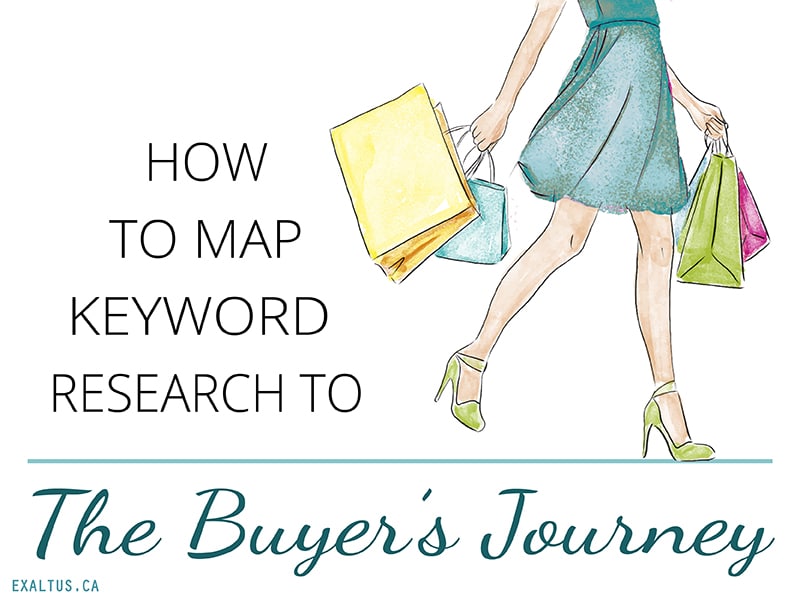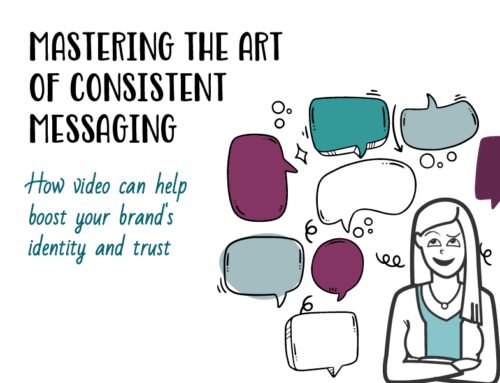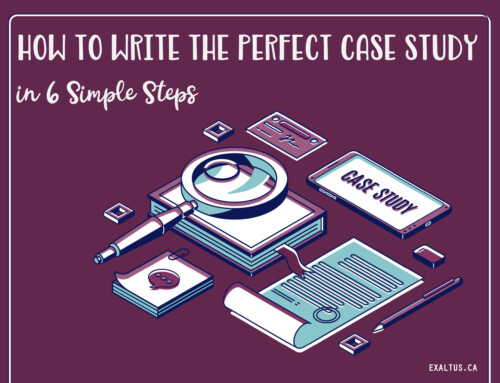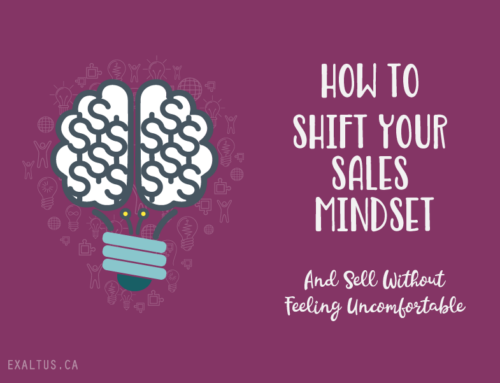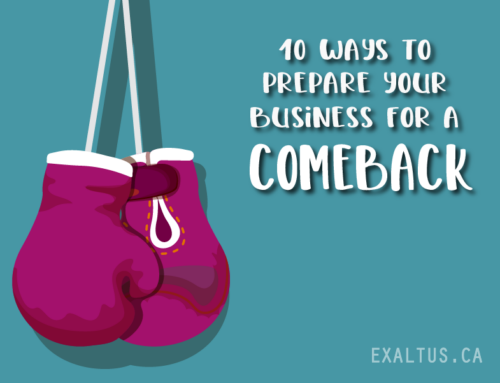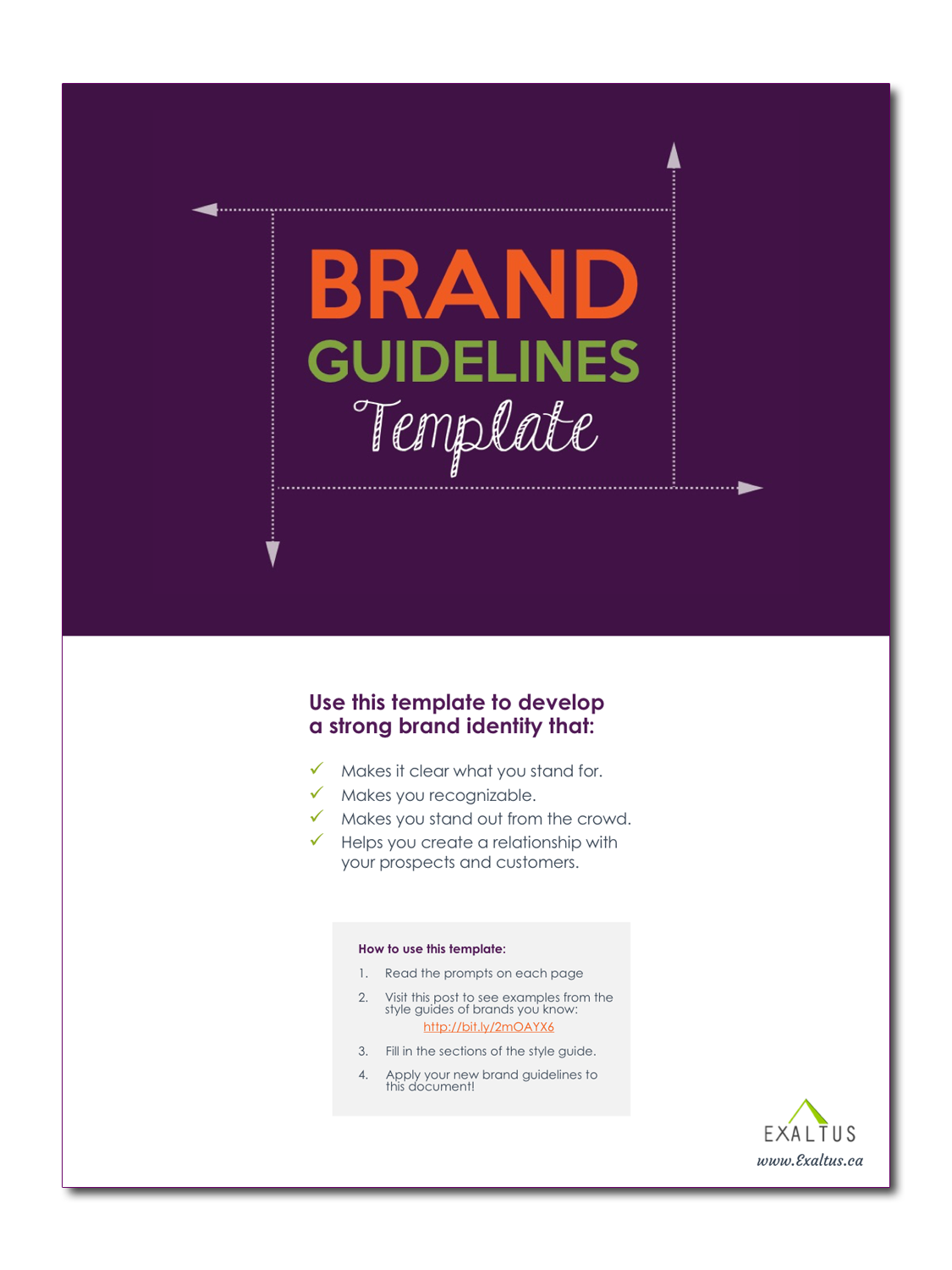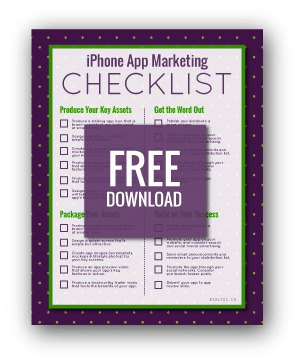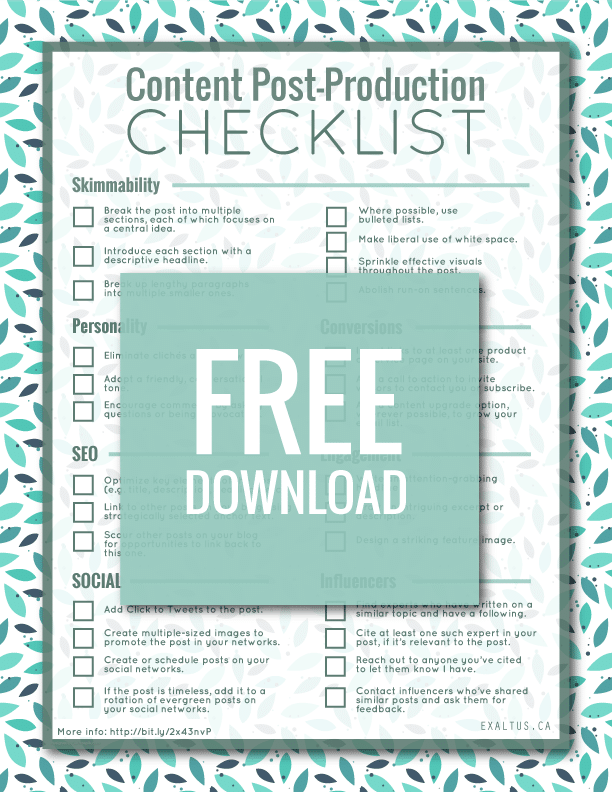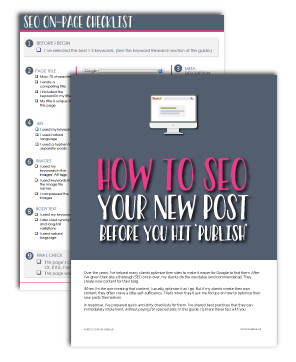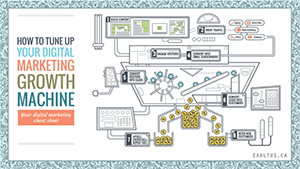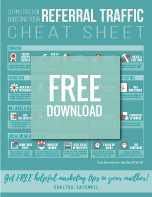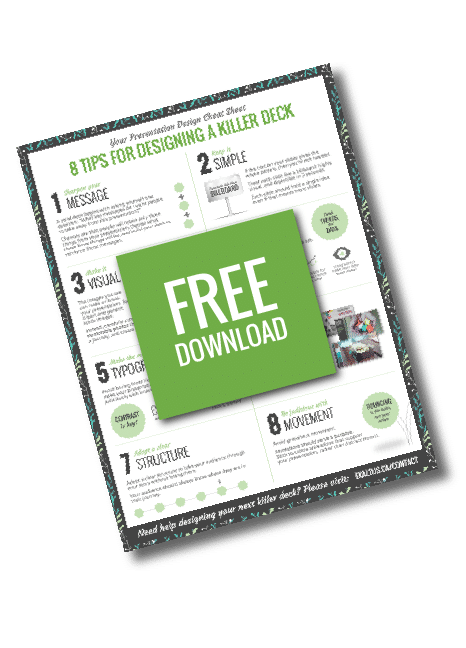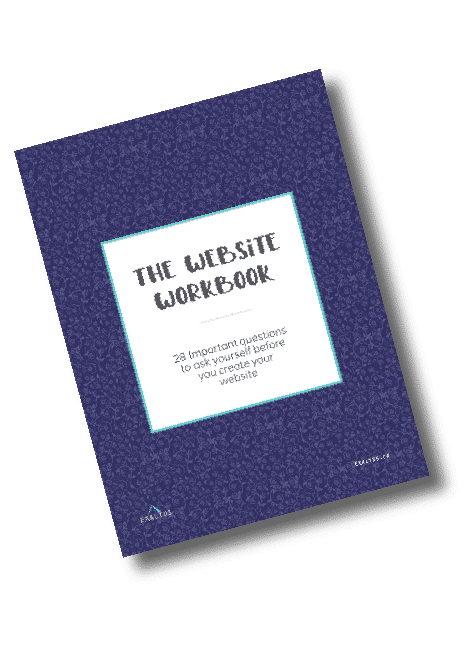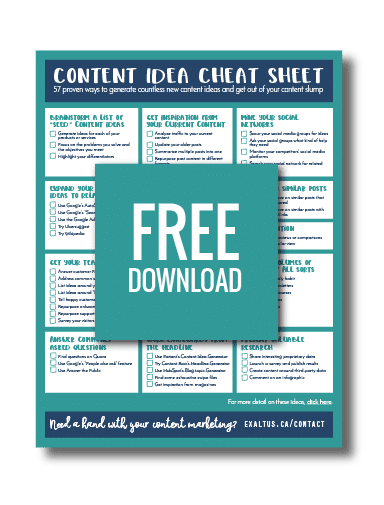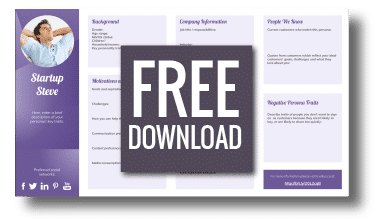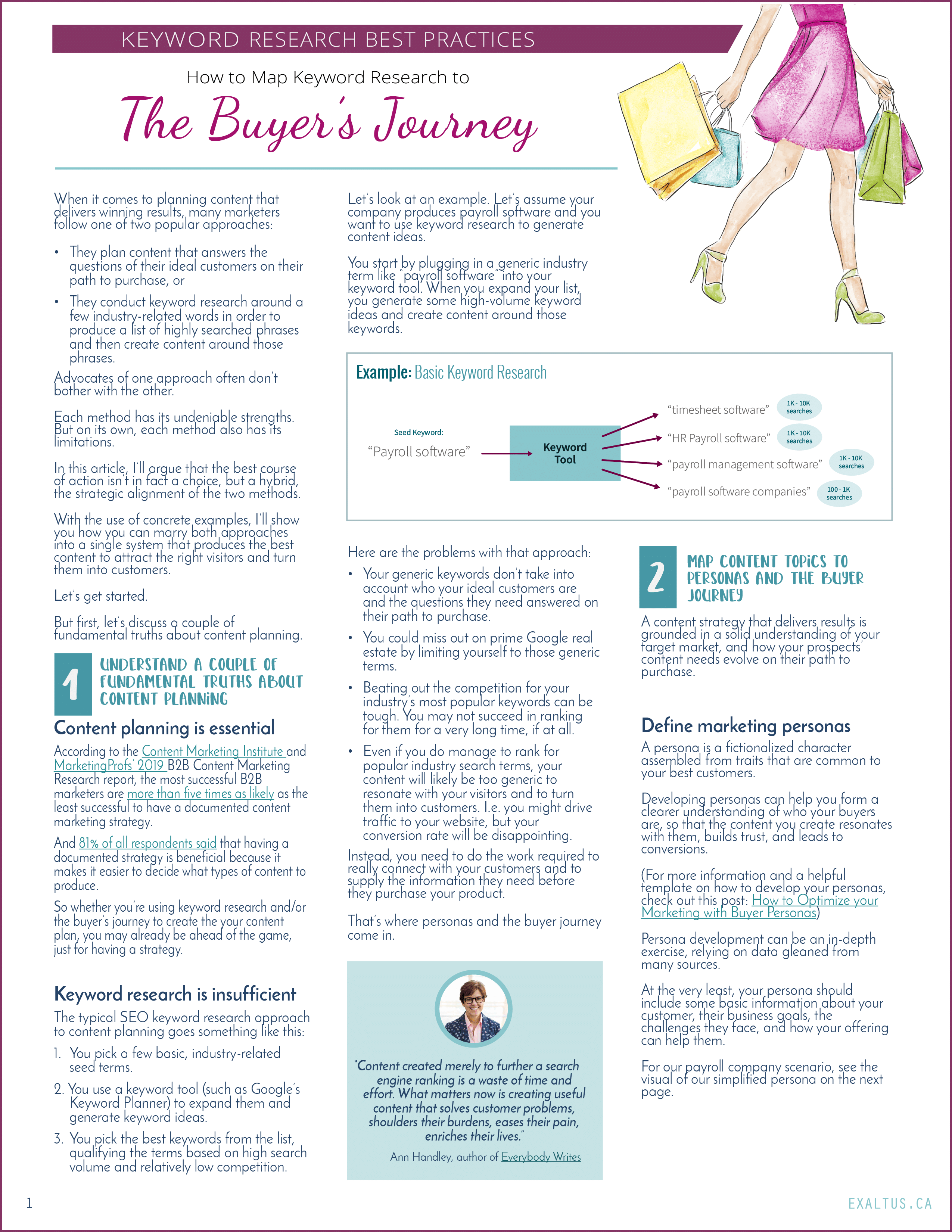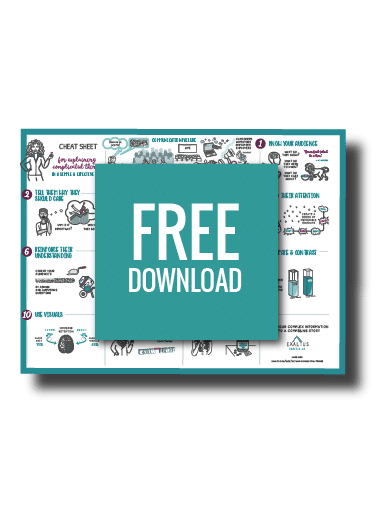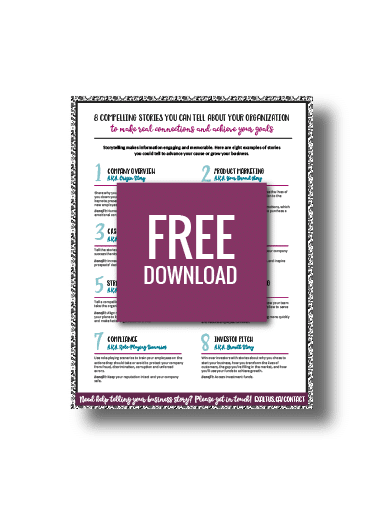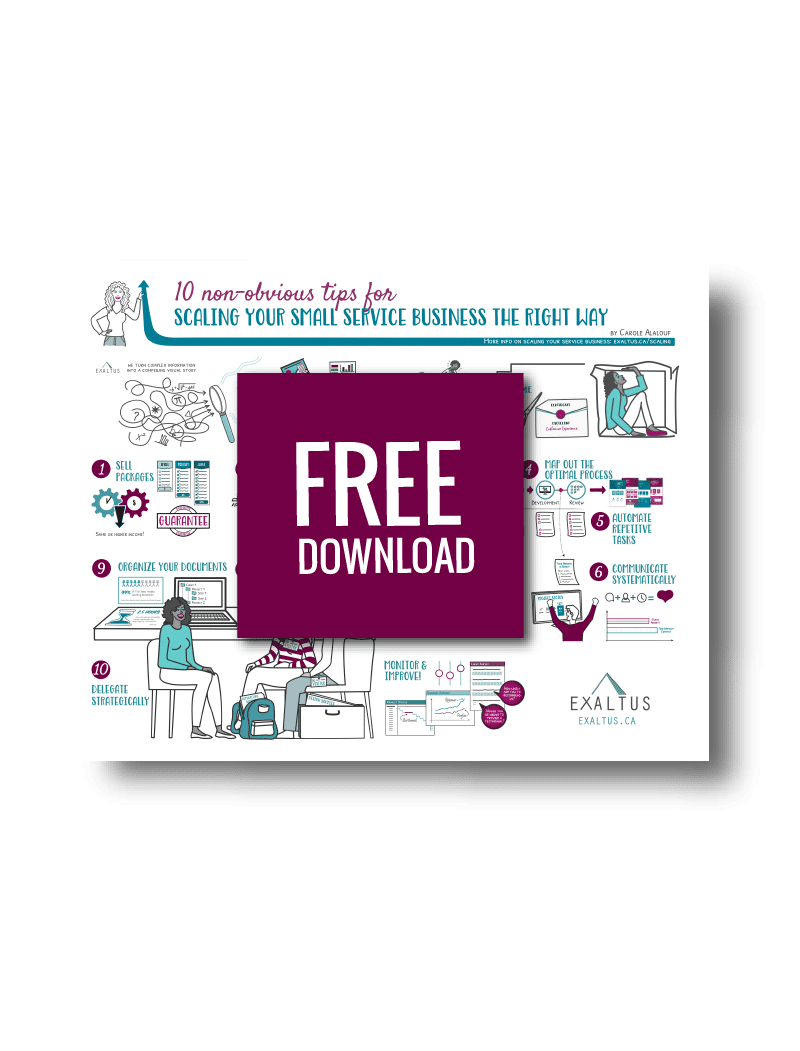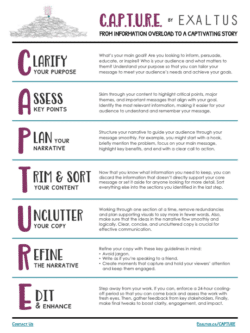Mapping your keyword research to marketing personas and the buyer’s journey (with examples)
When it comes to planning content that delivers winning results, many marketers follow one of two popular approaches:
- They plan content that answers the questions of their ideal customers on their path to purchase, or
- They conduct keyword research around a few industry-related words in order to produce a list of highly searched phrases and then create content around those phrases.
Advocates of one approach often don’t bother with the other.
Each method has its undeniable strengths. But on its own, each method also has its limitations.
In this article, I’ll argue that the best course of action isn’t, in fact, a choice, but a hybrid, the strategic alignment of the two methods.
With the use of concrete examples, I’ll show you how you can marry both approaches into a single system that produces the best content to attract the right visitors and turn them into customers.
Let’s get started.
But first, let’s discuss a couple of fundamental truths about content planning.
1. Understand a couple of fundamental truths about content planning
Content planning is essential
According to the Content Marketing Institute and MarketingProfs’ 2019 B2B Content Marketing Research report, the most successful B2B marketers are more than five times as likely as the least successful to have a documented content marketing strategy.
And 81% of all respondents said that having a documented strategy is beneficial because it makes it easier to decide what types of content to produce.
So whether you’re using keyword research and/or the buyer’s journey to create the your content plan, you may already be ahead of the game for having a strategy.
Keyword research is insufficient
The typical SEO keyword research approach to content planning takes you through these steps:
- Start with a few basic, industry-related seed terms.
- Expand the list of terms using a keyword tool, like Google’s Keyword Planner.
- Select the best keywords from the list, qualifying the terms based on high search volume and relatively low competition.
Let’s look at an example. Let’s assume your company produces payroll software and you want to use keyword research to generate content ideas.
You start by plugging in a generic industry term like “payroll software” into your keyword tool. When you expand your list, you generate some high-volume keyword ideas and create content around those keywords.

Here are the problems with that approach:
- Your generic keywords don’t take into account who your ideal customers are and the questions they need answered on their path to purchase.
- You could miss out on prime Google real estate by limiting yourself to those generic terms.
- Beating out the competition for your industry’s most popular keywords can be tough. You may not succeed in ranking for them for a very long time, if at all.
- Even if you do manage to rank for popular industry search terms, your content will likely be too generic to resonate with your visitors and to turn them into customers. I.e. you might drive traffic to your website, but your conversion rate will be disappointing.
Instead, you need to do the work required to really connect with your customers and to supply the information they need before they purchase your product.
That’s where personas and the buyer journey come in.
2. Map content topics to personas and the buyer journey
A content strategy that delivers results is grounded in a solid understanding of your target market, and how your prospects’ content needs evolve on their path to purchase.
Define marketing personas
A persona is a fictionalized character assembled from traits that are common to your best customers.
Developing personas can help you form a clearer understanding of who your buyers are, so that the content you create resonates with them, builds trust, and leads to conversions.
(For more information and a helpful template on how to develop your personas, check out this post: How to Optimize your Marketing with Buyer Personas)
Persona development can be an in-depth exercise, relying on data gleaned from many sources.
At the very least, your persona should include some basic information about your customer, their business goals, the challenges they face, and how your offering can help them.
For our payroll company scenario, this is a simplified definition of our persona:
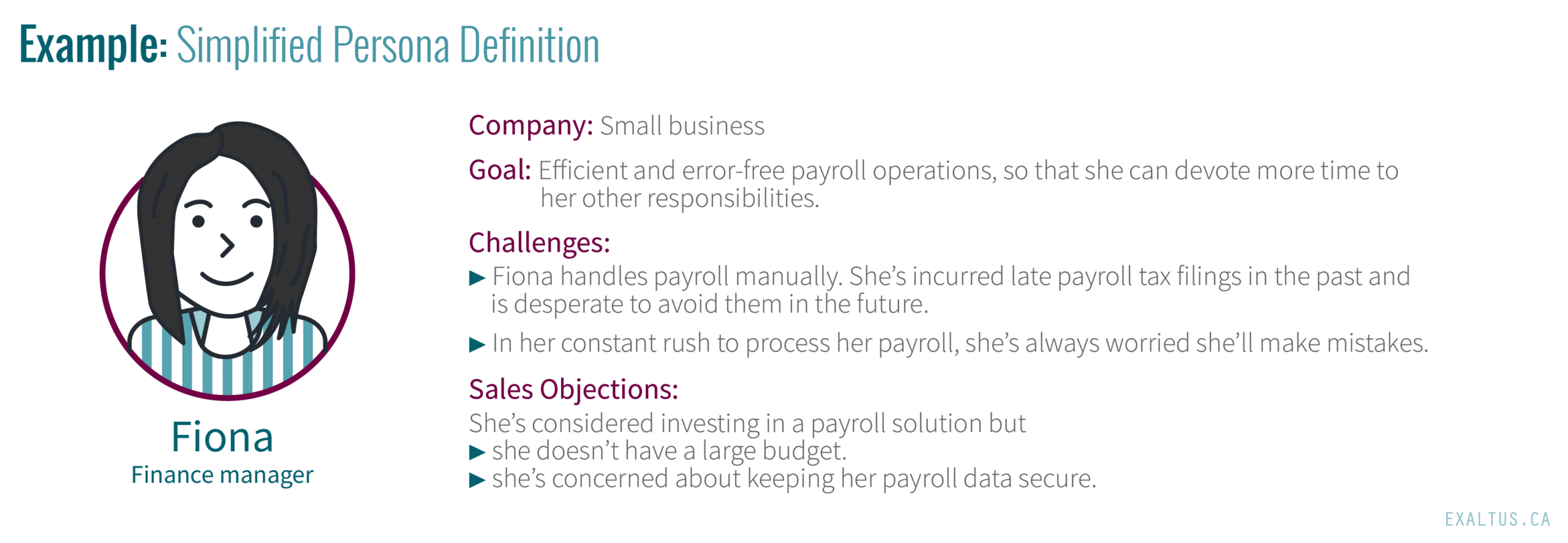
Map content to the buyer journey
After you develop your persona, the next step is to understand, from conversations with your customers and customer-facing team, how his or her needs evolve through the three key stages of the buyer journey. This will enable you to provide the content they need at each stage.
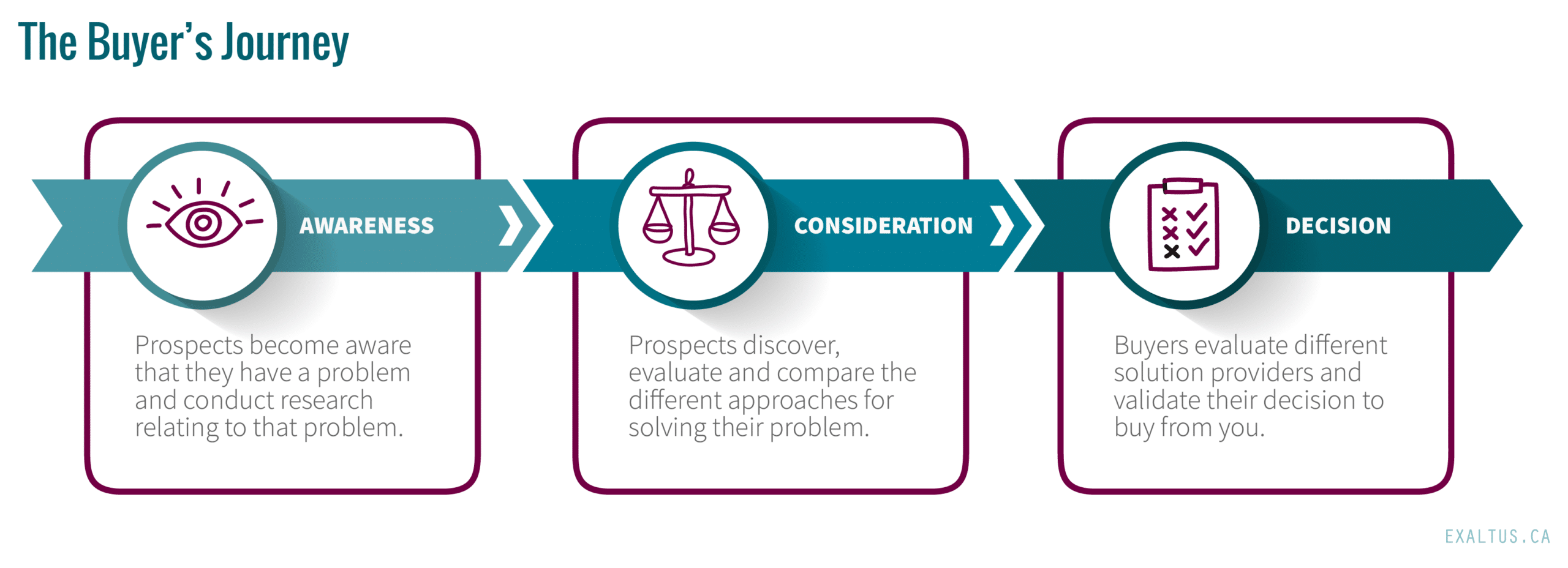
If you can supply the content your prospects need when they need it, you’ll reinforce your authority and gently nudge them along from stage to stage until they become your customers.
Content for the Awareness stage
During the Awareness stage, prospects become aware that they have a problem and conduct research relating to that problem.
For this stage, you need content around the pain points that your solution addresses for your persona.
In our scenario, Fiona the Finance Manager may need convincing that she has to make a change to address her payroll issues. What content can you produce to convince her? Here are some examples.

As you might expect, people searching for awareness-stage queries are not likely to make a purchase on their first visit. Still, getting in front of prospects at this early stage is a great way to build trust and authority, to be seen before your competitors are, and to nudge them along the path to purchase.
Content for the Consideration stage
During the Consideration stage, your prospects discover, evaluate and compare the different approaches they could take to solve their problem.
Ideal content for this stage will:
- Present the different approaches available to solve your customer’s problems.
- Highlight the pros and cons of the different approaches.
- Steer your prospects toward your type of solution.
In our scenario, Fiona the Finance Manager may need convincing that she has to make a change to address her payroll issues. What content can you produce to convince her? Here are some examples.

Content for the Decision stage
During the Decision stage, buyers may be evaluating different solution providers and validating their decision to buy from you.
Your content should:
- Present the relative strengths of your offering.
- Address any lingering concerns and objections.
In our scenario, here are just a few examples of content you could produce for the Decision stage.

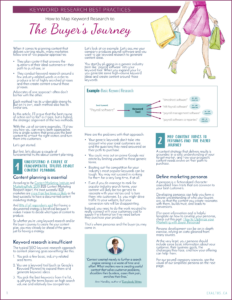
Don’t have time to read this post?
Download the PDF guide for later and learn how to get in front of your ideal customers on their path to purchase.
So we’re done now, right?
Using the persona and buyer stage approach, we can brainstorm loads of content topics to cover, and even some of the questions we need to answer for our persona.
But we can do better. How? By introducing keyword research to enrich the strategy with data-driven insights.
3. Use keyword research to select the right keywords for each persona and stage
Keyword research removes dangerous assumptions
It’s true: Without any further research, you could start creating content based solely on the persona and buying journey approach.
The problem with doing that is that you risk making some big assumptions. Assumptions about:
- The specific questions your prospects have with respect to your broad topics
- The precise search queries your prospects are using in their research
- Which search terms you’re likeliest to rank for
- The right language to use in your content to resonate with your ideal customer
Making those assumptions can be costly.
Keyword research is about so much more than SEO. Keyword research is market research. It offers insight into the way buyers think.
Applied correctly, keyword research can be a powerful partner to personas and the buyer’s journey. I asked Andy Crestodina, co-founder of Orbit Media, to weigh in on the role of keyword research. This is what he had to say:
Align keyword research to the buyer’s journey
Earlier, we talked about the limitations of using keyword research on its own as a means of generating content ideas.
Now, we’ll see how we can go about keyword research the right way.
And here’s the trick:
Instead of plugging generic industry terms into your keyword tool, you plug in the topics that are specifically relevant to your persona, at each stage of the buyer’s journey.
Questions and keywords for the Awareness stage
At the Awareness stage, use keyword research to find keywords that map to your persona’s pain points, by using those pain points as seed topics in your keyword tool.
In our scenario, we know that Fiona is concerned about payroll mistakes and late filing penalties. We expanded those terms and found a couple of commonly asked questions and some keyword ideas:
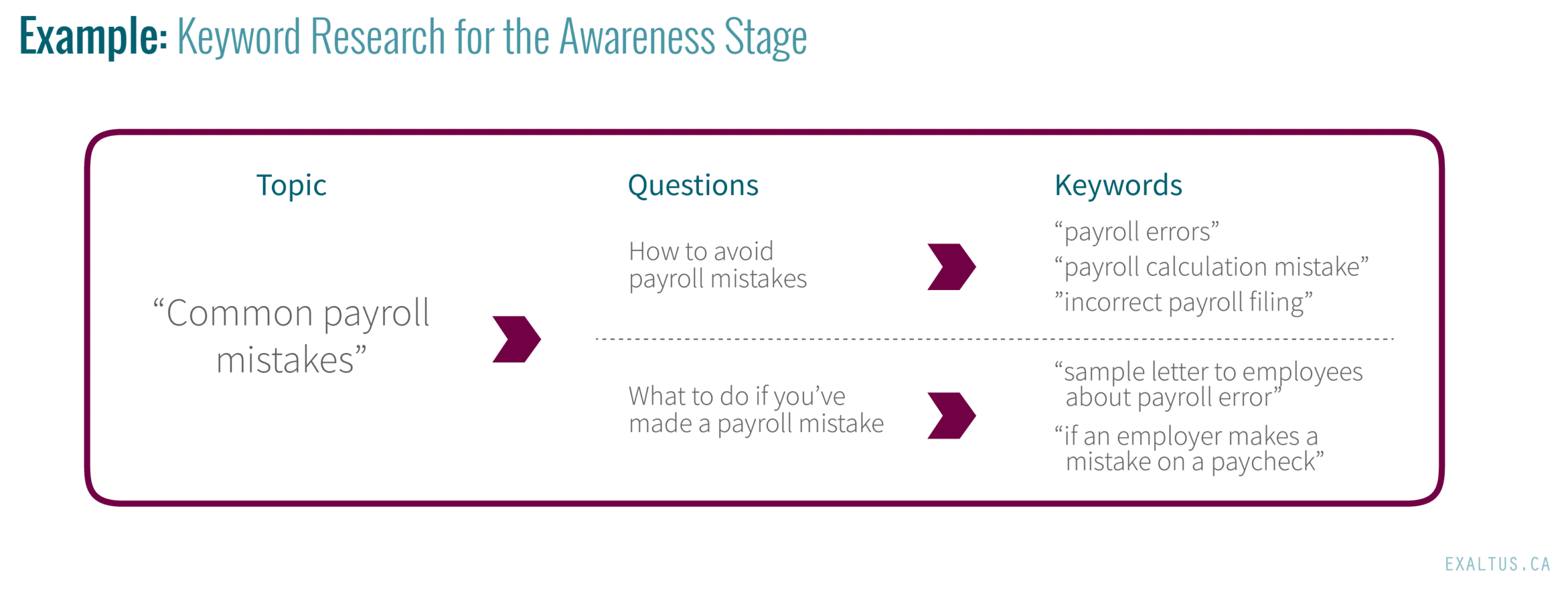

Are lower search volumes worth the effort?
You’ll notice, when you use this approach, that some of your search terms will have very low search volumes. And they’ll seem even lower when you contrast them with the high search volumes of popular short-tail keywords.
(For example, “payroll management software” is searched thousands of times per month. By contrast, “payroll calculation mistake” is searched fewer than a hundred times per month.)
Here’s why creating content and optimizing it for these search terms is still worth the effort:
- In aggregate, the searches targeted by all of your content ideas will start to add up.
- The quality of visitors those searchers attract will be higher since you’re reaching the right people at the right time.
- It doesn’t matter how many people search for the generic short-term keywords, if you’re never able to rank for them and if they attract the wrong people.
Questions and keywords for the Consideration stage
For the Consideration stage, you’re looking for keywords about the different types of solutions available to solve the persona’s problems, as well as keywords related to your type of solution.
In our scenario, by the time Fiona is at the Consideration stage, she’s convinced she needs a solution to her payroll woes. But she’s not yet sure what the right solution is.
Here are some of the questions Fiona is likely to ask, and terms she is likely to search:
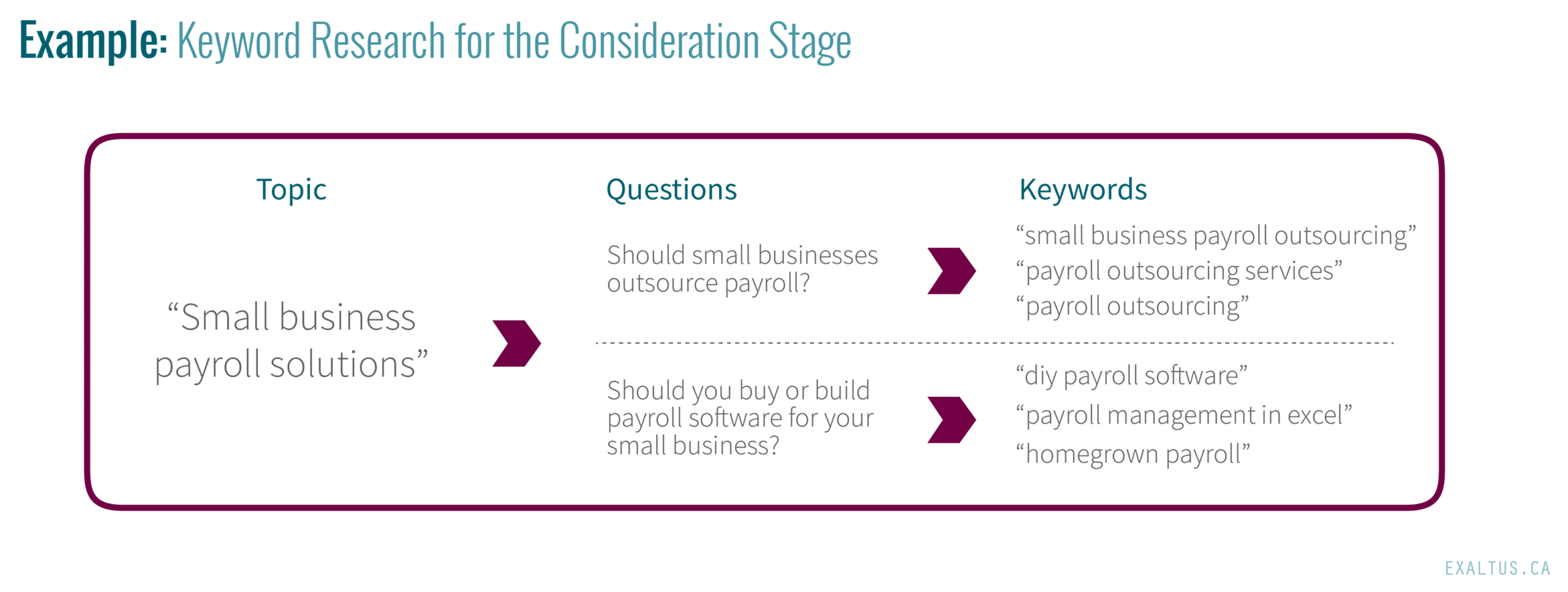
Questions and keywords for the Decision stage
Finally, at the Decision stage, you’re trying to find the questions and search terms your prospects are using to:
- compare the different vendors offering solutions like yours
- understand the major product or service differentiators
- research the areas they may have residual concerns about.
In our scenario, by the time Fiona reaches the Decision stage, she has decided to purchase payroll software but wants to make sure she chooses the right one and to quiet any niggly worries.
Here are questions she may be asking and keywords she might be using in her research.
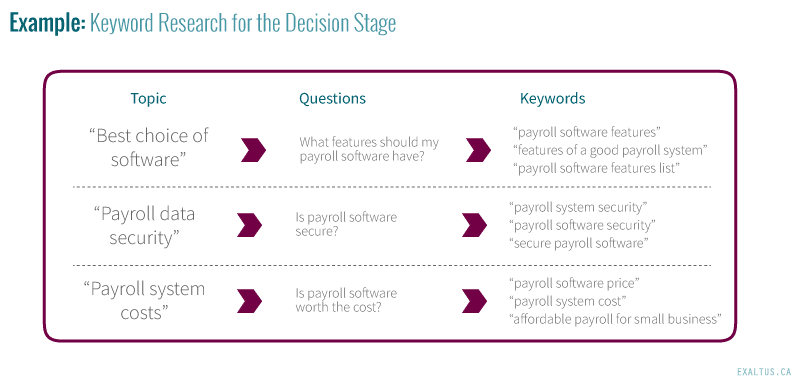
4. Disqualify keywords
Through your keyword research, you’ll discover many search terms you could use for each content piece. Which do you select as your primary keywords and which do you discard? That decision merits a bit of thought. Here are a few considerations:
- If possible, avoid competitive keywords that you have no hope of ranking for. In my examples, you can tell that by looking at the difficulty score: the higher the score, the harder it will be to rank for.
Tip: If you want some great tips on how to actually predict whether or not you’ll manage to rank for a term, check out the keyword research section of this amazing post by Andy Crestodina: How to Write a Blog Post That Ranks High: 13 Steps for Writing SEO Articles (plus, high-speed video). Andy’s approach is downright scientific.
- As you’re prioritizing your keywords, always keep your persona in mind. Weed out any questions you think they wouldn’t ask, or search terms you think they wouldn’t use.
5. Check out the competition
A little competitive analysis is a good idea when you’re conducting your keyword research. Specifically, check out:
- The terms your competitors rank for at each step of the buyer’s journey.
- The content they’ve created that serves the needs of your persona.
Your goal is not to blindly emulate. It is to understand what content is already available, so that you can one-up it, and fill any content gaps.
6. Follow through with your content creation
Once you’ve completed this hybrid approach, you should have a ton of great content ideas. Here are a few bonus tips for capitalizing on all that planning work.
Create great content for customers and search engines
Make sure that the methodology you have applied to planning follows through into your content creation. That is, produce each piece of content with several objectives in mind:
- Answer all your persona’s questions on their path to purchase.
- Mirror back the language your prospects use.
- On-page optimize it for your targeted keywords, so that it will rank on Google.
Conduct semantic analysis
Strengthen your SEO with semantic analysis.
I like to use a tool called TextOptimizer, which proposes related keywords to include in my piece, in order to increase the likelihood of high search rankings.
Here are a few of the suggestions that were proposed to me when I plugged in “payroll software security” into Text Expander:
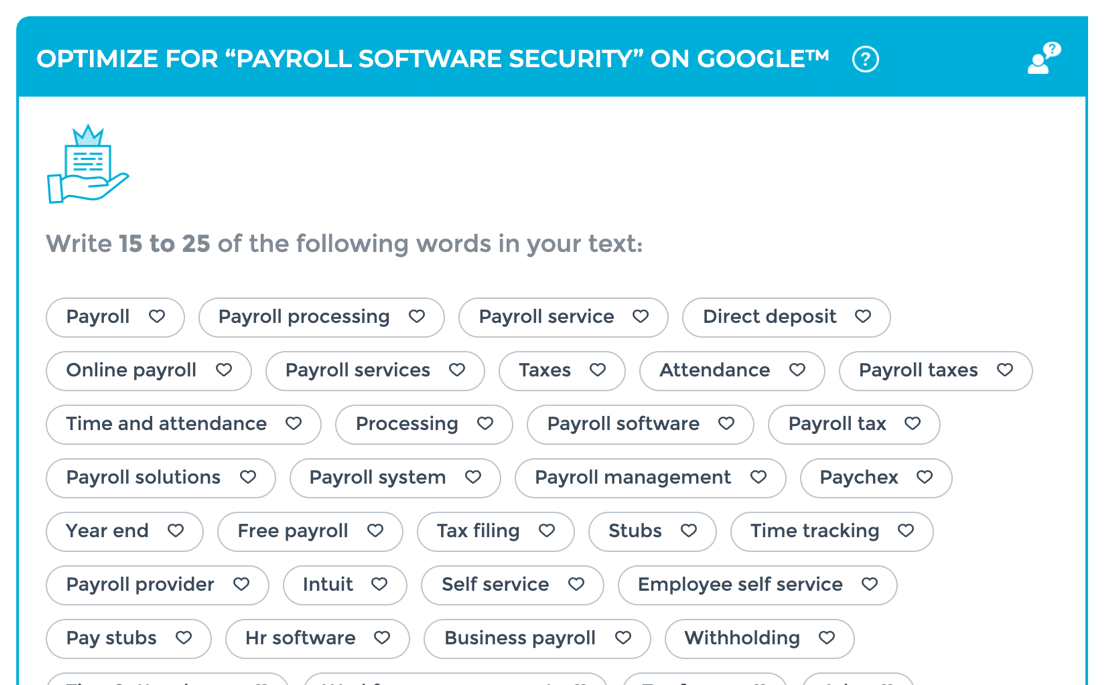
Nudge prospects along their journey
Visitors reading content designed for one stage should find it easy to discover the content you’ve created for the next. How? Here are just a couple of ideas:
- Create internal links in all your content to articles at the next stage of the buying journey.
- Create irresistible lead magnets to entice visitors to sign up to your email list, and then send them the right content to nudge them along the buyer’s journey.
Additional resources
If you’d like more detail on some tools and techniques you can use to generate content ideas within this framework, you may want to check out this article on 57 Proven Ways to Generate Countless New Content Ideas.
Or if you’d just like someone to handle the entire content marketing process for you, check out our Blog in a Box content marketing plan.
Over to you
I hope that following this approach will make it easier for your prospects to find you, trust you, and become your new customers. If you have any questions that I haven’t addressed, I’d love to hear from you in the comments.
Finally, if you liked this post, please let me know by signing up to my email list!

